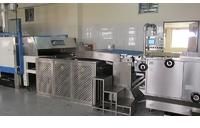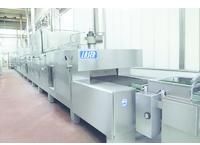
Hybrid Oven
The amount of heat required by a dough piece varies throughout the baking process. High amount of heat is required at the beginning and once the structure is established the amount of heat required is more and needs to be gentle. For such type of baking process, we generally recommend a Hybrid type of Oven which consists of a radiating heat in the beginning followed by convection heating towards the end of baking process. Different types of heat can have different effects on the final product. Hence it is ideal for recipes that require mixed-heat requirements. This can be a combination of the following with or without Turbulence: Direct Gas Fired Indirect Gas fired Cyclotherm Direct or Indirect Convection Advantages: Flexibility of Baking process with different products in the same oven Fine texture and Crispy end products Uniformity in Colour across the width Moisture Uniformity in each piece Greater Control over the final moisture content of the products
...more
Direct Gas Fired Oven
This type of Oven is ideal for Crackers (cream & soda). Snacks / fermented products which requires short baking time and high heat input especially at the beginning of the baking cycle. On request, the oven can be fitted with a turbulence system, which can enhance uniform baking conditions. It is a high efficiency oven in terms of heat transfer. The humid environment in the baking chamber is comparatively higher than that of other types of ovens. This humid environment prevents a skin from forming on the surface of the dough, and hence the baked product can fully expand in height, while also ensuring more efficient extraction of further humidity from the centre of the dough piece. For more details on the number and type of burners required for your type of recipe, kindly send in your enquiry. Our Consultants will help you suggest the right configuration suitable for specific applications
...more
Cyclothermic Oven
Also known as Indirect Radiating (Cyclotherm). This is ideal where the method of heat transfer is when gentle baking is required. Preferred for the production of hard sweet, rotary moulded, wirecut or deposited biscuits. With a slat type of conveyor, it can also be utilized for baking products in metal trays such as cakes, muffins or bread. Avail from us advanced technology, which is appreciated for compact and elegant design. This oven is provided with user friendly controls. It is also equipped with digital temperature indicating controller with safety thermostat. Heat transfers in this type of oven is mainly by radiation. The baking chamber comprises of a set of tubes set above and below the conveyor, which transfers the heat to the dough pieces. A burner heats the hot air which is forced the tubes with the aid of a fan blower. One of the main feature, the fuel combustion products never comes in contact with the dough pieces.
...more
Convection Oven
We are offering the best quality array of Convection Oven. This assortment is very much demanded in kitchens for making assorted types of recipes in a perfect manner. Offered product is available in assorted designs, shapes and varied technical specifications in order to meet the utmost satisfaction of the clients. Direct Convection This type of Oven, is preferred when the dough requires heat by means of hot air. Air is heated upto 220 – 250 C and conveyed to the baking chamber and blown to the top and the bottom of the product being baked. This is uniformly distributed throughout the baking chamber. This type of baking is typically used in the last sections of a Hybrid Oven after the previous Direct Gas Fired section. Advantages. Provides better and more precise control of the final moisture Final colour of the products can be easily fine tuned Indirect Convection This type of heating is utilized in the Hybrid type after the Indirect radiating heated section of the oven. Even in this type of Oven, the heat is transferred to the dough by means of hot air. A heat exchanger facilitates this transfer in order to avoid any contamination of the air that comes into contact with the product being baked. This is then conveyed to the baking chamber which is at a temperature of around 200 C and then blown to the top and the bottom of the product. Advantages: Since the transfer of heat is through exchangers, hot air which comes in contact with the dough does not contain any combustible product. Better Operator Controls in each zone / baking chamber temperature / top and bottom heat ratio Better extraction of moisture from the chamber.
...moreBe first to Rate
Rate ThisOpening Hours